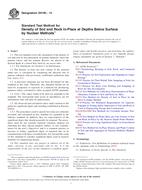Potřebujeme váš souhlas k využití jednotlivých dat, aby se vám mimo jiné mohly ukazovat informace týkající se vašich zájmů. Souhlas udělíte kliknutím na tlačítko „OK“.
ASTM D5195-14
Standard Test Method for Density of Soil and Rock In-Place at Depths Below Surface by Nuclear Methods
Automaticky přeložený název:
Standardní zkušební metoda pro Hustota zemin a hornin v místě v hloubkách pod povrchem jadernými metody
NORMA vydána dne 1.7.2014
Informace o normě:
Označení normy: ASTM D5195-14
Poznámka: NEPLATNÁ
Datum vydání normy: 1.7.2014
Kód zboží: NS-30229
Počet stran: 7
Přibližná hmotnost: 21 g (0.05 liber)
Země: Americká technická norma
Kategorie: Technické normy ASTM
Kategorie - podobné normy:
Zemní práce. Hloubicí práce. Budování základů. Podzemní práce
Anotace textu normy ASTM D5195-14 :
Keywords:
depth probe, in-place density, in situ density, nuclear methods, ICS Number Code 93.020 (Earth works. Excavations. Foundation construction. Underground works)
Doplňující informace
| Significance and Use | ||||||||||||||||||||||
|
4.1 This test method is useful as a rapid, nondestructive technique for the calculation of the in-place density of soil and rock at desired depths below the surface as opposed to surface measurements in accordance with Test Method D6938. 4.2 This test method is useful for informational and research purposes. It should only be used for quality control and acceptance testing when correlated to other accepted methods such as Test Method D2937. 4.3 The non-destructive nature of the test method allows repetitive measurements to be made at a single test location for statistical analysis and to monitor changes over time. 4.4 The fundamental assumptions inherent in this test method are that Compton scattering and photoelectric absorption are the dominant interactions of the gamma rays with the material under test. Note 1: The quality of the result produced by this standard
test method is dependent on the competence of the personnel
performing it, and the suitability of the equipment and facilities
used. Agencies that meet the criteria of Practice D3740 are generally considered capable of
competent and objective testing/sampling/inspection, and the like.
Users of this test method are cautioned that compliance with
Practice D3740 does not in
itself assure reliable results. Reliable results depend on many
factors; Practice D3740
provides a means of evaluating some of those factors.
|
||||||||||||||||||||||
| 1. Scope | ||||||||||||||||||||||
|
1.1 This test method covers the calculation of the density of soil and rock by the attenuation of gamma radiation, where the gamma source and the gamma detector are placed at the desired depth in a bored hole lined by an access tube. 1.1.1 For limitations see Section 5 on Interference. 1.2 The density, in mass per unit volume of the material under test, is calculated by comparing the detected rate of gamma radiation with previously established calibration data (see Annex A1). 1.3 A precision statement has not been developed for this standard at this time. Therefore, this standard should not be used for acceptance or rejection of a material for purchasing purposes unless correlated to other accepted ASTM standards. 1.4 Units—The values stated in SI units are regarded as the standard. The inch-pound units given in parentheses are for information only and may be approximate. 1.5 All observed and calculated values shall conform to the guide for significant digits and rounding established in Practice D6026. 1.5.1 The procedures used to specify how data are collected, recorded, and calculated in this standard are regarded as the industry standard. In addition, they are representative of the significant digits that should generally be retained. The procedures used do not consider material variation, purpose for obtaining the data, special purpose studies, or any considerations for the user’s objectives; and it is common practice to increase or reduce significant digits of reported data to be commensurate with these considerations. It is beyond the scope of this standard to consider significant digits used in analysis methods for engineering design. 1.6 This standard does not purport to address all of the safety concerns, if any, associated with its use. It is the responsibility of the user of this standard to establish appropriate safety and health practices and determine the applicability of regulatory limitations prior to use. Specific precautionary statements are given in Section 7, “Hazards.” |
||||||||||||||||||||||
| 2. Referenced Documents | ||||||||||||||||||||||
|
Doporučujeme:
Aktualizace technických norem
Chcete mít jistotu, že používáte pouze platné technické normy?
Nabízíme Vám řešení, které Vám zajistí měsíční přehled o aktuálnosti norem, které používáte.
Chcete vědět více informací? Podívejte se na tuto stránku.




 Cookies
Cookies
